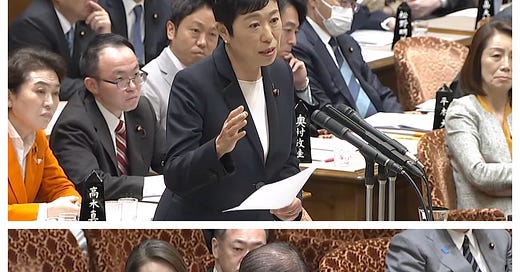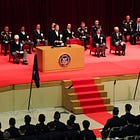Thank you for reading Observing Japan. This post is available to all readers.
If you are looking for timely, forward-looking analysis of the stories in Japans’s politics and policymaking that move markets, I have launched a new service through my business, Japan Foresight LLC. For more information about Japan Foresight’s services or for information on how to sign up for a trial or schedule a briefing, please visit our website or reach out to me.
I was recently interviewed by The Nikkei Shimbun about Japan’s political reform debate. The story is available here.

Prime Minister Ishiba Shigeru, already reeling from the gift-giving scandal, now has another headache, with the Trump administration’s decision to impose 25% tariffs on automobiles on 2 April.
It is hard to understate the impact these tariffs could have on Japan’s economy. NHK provides a useful summary of Japan’s automobile exports to the United States and the potential costs.
Japan exported 1.3 million automobiles to the United States, a third of its total automobile exports.
These automobile exports had a total value of JPY 6.26tn, 28.3% of Japan’s exports to the US.
Small automakers – Subaru, Maza, and Mitsubishi – produce fewer vehicles in the United States and are more vulnerable to the tariffs than the bigger manufacturers.1
The tariffs alone could reduce Japan’s GDP by 0.2% or 0.3%, with downstream impacts on suppliers, steelmakers, and other manufacturers.
Nikkei estimates that a 10% drop in Japan’s automobile exports to the United States could mean a JPY 1.3tn drop in Japan’s GDP. There could be additional effects on Japan’s economy if the tariffs lead the dollar to strengthen against the yen, triggering further inflation through costlier imports of food and energy, complicating the Ishiba government’s efforts to boost real household incomes ahead of the July upper house elections. As the Cabinet Office’s March Monthly Economic Report put it – in typical bureaucratic understatement – “the effect of continued price increases on private consumption through a downturn in consumer sentiment and the impact of policy trends in the U.S. such as trade policy are downside risks to Japanese economy,” identifying the Trump administration’s trade policy as a singular threat instead of one among many as in the February report.
The prime minister and other members of his government called Donald Trump’s decision “extremely regrettable.” “We will consider the best way to make them understand that it is not in the best interest of the United States,” Ishiba said. “We will do our utmost to realize our national interests.” Liberal Democratic Party (LDP) policy chief Onodera Itsunori communicated these concerns to Joseph Young, the US chargé d'affaires ad interim in Tokyo.
Despite these concerns, however, the Ishiba government appears to be constrained in its response. Unlike other US trading partners, whose governments have outlined retaliatory measures they will impose in response to the tariffs, the Ishiba government has mainly responded by restating its commitment to negotiate exemptions from the automobile tariffs, as well as from the pending but still unspecified reciprocal tariffs. The desire to avoid wider friction with the United States that could weaken the bilateral security relationship has tied the Ishiba government’s hands and even led the government to contemplate concessions to the United States on regulatory changes that might address US concerns about Japan’s non-tariff barriers. Japan also wants to respect the World Trade Organization’s (WTO) dispute settlement process, which at this point may be more of a symbolic commitment than an effective way of resolving a dispute.
The problem for Ishiba is that the public and the opposition parties may be less inclined to accept the Trump administration’s actions passively, particularly since the late Abe Shinzō repeatedly said following the signing of the bilateral US-Japan free trade agreement that Trump promised that he would not raise automobile tariffs on Japan. Even before the automobile tariffs were announced, a Mainichi Shimbun poll found that 58% of respondents would support imposing retaliatory tariffs. The Constitutional Democratic Party (CDP), perhaps sensing an opportunity, announced a new task force on 28 March to consider how to respond to the US tariffs, suggesting a range of responses including suspending or renegotiating the FTA; revising domestic laws to enable Japan to levy more forceful retaliatory measures; and proposing a non-binding parliamentary resolution. Meanwhile, in parliamentary questioning after the tariffs were announced, CDP lawmaker Tsujimoto Kiyomi forcefully questioned Ishiba in the upper house budget committee, among other things pointing to Trump’s broken promise to Abe.
What is interesting about the CDP’s response is not necessarily the substance of its proposals, but rather its potential political significance, particularly whether this results in the mainstreaming of a more explicit Gaullism in Japanese politics. The prevailing rule in Japanese politics has, of course, been that political leaders must first and foremost demonstrate their ability to manage the relationship with the United States — for which CDP leader Noda Yoshihiko’s erstwhile colleague Hatoyama Yukio paid a severe price for failing to respect. It is worth watching now whether the auto tariff shock could, through its potential impact on Japan’s economy, the Ishiba government’s passivity, and the widening gap between Japan and the United States in their views on the importance of a rules-based international order change the political calculus around the bilateral relationship. Perhaps the gravitational pull of the security relationship will continue to govern all, and the CDP will gain nothing from this positioning. But it bears watching, particularly heading into the upper house elections.
More immediately, it is worth watching whether the tariff issue worsens Ishiba’s odds of survival. His rivals on the LDP’s right, while not necessarily calling for a more assertive response to the automobile tariffs, have already been questioning Ishiba’s leadership and casting Ishiba’s diplomacy with Trump in an unfavorable light compared with Abe’s.2 Kobayashi Takayuki, who has made little secret of his desire to replace Ishiba, recently hosted a meeting of his study group with roughly fifty LDP lawmakers in attendance in which criticism of the prime minister’s performance featured heavily. It is conceivable that Kobayashi or Motegi Toshimitsu, who campaigned as a “Trump whisperer” last year on the basis of Trump’s praise for his negotiating skills during the bilateral FTA talks, could use Ishiba’s handling of the automobile tariffs — as well as his plummeting approval ratings — to press for Ishiba’s removal. There may be some in the LDP who are rethinking Motegi’s fitness in light of recent events. In practice, Ishiba’s LDP rivals may not be able to do much different than Ishiba,3 but Ishiba may nevertheless suffer from appearing weak, particularly if and when the impact of the automobile tariffs become more apparent.
Perhaps this discussion is premature, given the lingering sense that there is no alternative to the US-Japan alliance. Nevertheless, it does seem that the Japanese political system may, ever so gradually, begin adapting to the realities of the new world order.4
According to this summary, 20% of Toyota’s sales, 1% of Honda’s, and 15% of Nissan’s sales are imported from Japan, compared with 64%, 48%, and 85% for Mazda, Subaru, and Mitsubishi. That said, Toyota, Honda, and Nissan also export from Canada and Mexico.
Whether this comparison is fair or not, since the second Trump administration is clearly very different from the first.
Nishida Shōji, a particularly outspoke right-wing critic of Ishiba, says in a Youtube video that Trump’s tariffs are a “golden opportunity” to reorient Japan’s economy around consumption.
Leo Lewis’s meditation on Japan’s adaptability is worth reading.




